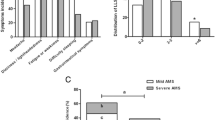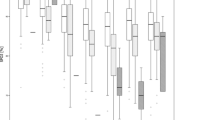Abstract
Introduction
The study evaluated the predictive value of arterial oxygen saturation (SaO2) after 30-min hypoxic exposure on subsequent development of acute mountain sickness (AMS) and tested if additional resting cardio-respiratory measurements improve AMS prognosis.
Methods
Fifty-five persons were exposed to a simulated altitude of 4,500 m (normobaric hypoxia, FiO2 = 12.5 %). Cardio-respiratory parameters, SaO2, blood lactate, and blood pressure were measured after 30 min of exposure. AMS symptoms were recorded after 3, 6, 9, and 12 h (Lake-Louise Score). Three models, based on previously published regression equations for altitude-dependent SaO2 values of AMS-susceptible (SaO2-suscept = 98.34 − 2.72 ∗ alt − 0.35 ∗ alt2) and AMS-resistant (SaO2-resist = 96.51 + 0.68 ∗ alt − 0.80 ∗ alt2) persons, were applied to predict AMS. Additionally, multivariate logistic regression analyses were conducted to test if additional resting measurements improve AMS prediction.
Results
The three models correctly predicted AMS development in 62 %, 67 %, and 69 % of the cases. No model showed combined sensitivity and specificity >80 %. Sequential logistic regression revealed that the inclusion of tidal volume or breathing frequency in addition to SaO2 improved overall AMS prediction, resulting in 78 % and 80 % correct AMS prediction, respectively.
Conclusion
Non-invasive measurements of SaO2 after 30-min hypoxic exposure are easy to perform and have the potential to detect AMS-susceptible individuals with a sufficient sensitivity. The additional determination of breathing frequency can improve success in AMS prediction.
Similar content being viewed by others
References
Burtscher M (1999) High-altitude headache: epidemiology, pathophysiology, therapy and prophylaxis. Wien Klin Wochenschr 111:830–836
Richalet JP, Donoso MV, Jiménez D, Antezana AM, Hudson C, Cortès G, Osorio J, Leòn A (2002) Chilean miners commuting from sea level to 4500 m: a prospective study. High Alt Med Biol 3:159–166
Muza SR (2007) Military applications of hypoxic training for high-altitude operations. Med Sci Sports Exerc 39:1625–1631
Burtscher M, Faulhaber M, Flatz M, Likar R, Nachbauer W (2006) Effects of short-term acclimatisation to altitude (3200 m) on aerobic and anaerobic exercise performance. Int J Sports Med 27:629–635
Faulhaber M, Gatterer H, Haider T, Patterson C, Burtscher M (2010) Intermittent hypoxia does not affect endurance performance at moderate altitude in well-trained athletes. J Sports Sci 28:513–519
Beidleman BA, Muza SR, Fulco CS, Cymerman A, Ditzler D, Stulz D, Staab JE, Skrinar GS, Lewis SF, Sawka MN (2004) Intermittent altitude exposures reduce acute mountain sickness at 4300 m. Clin Sci 106:321–328
Hamilton AJ, Trad LA, Cymerman A (1991) Alteration in human upper extremity motor function during acute exposure to simulated altitude. Aviat Space Environ Med 62:759–764
Regard M, Landis T, Casey J, Maggiorini M, Bärtsch P, Oelz O (1991) Cognitive changes at high altitude in healthy climbers and in climbers developing acute mountain sickness. Aviat Space Environ Med 62:291–295
Li X, Tao F, You H, Pei T, Gao Y (2011) Factors associated with acute mountain sickness in young Chinese men on entering highland areas. Asia Pac J Public Health. doi:10.1177/1010539511427956
Netzer N, Strohl K, Faulhaber M, Gatterer H, Burtscher M (2013) Hypoxia-related altitude illnesses. J Travel Med 20:247–255
Montgomery AB, Mills J, Luce JM (1989) Incidence of acute mountain sickness at intermediate altitude. JAMA 261:732–734
Maggiorini M, Buhler B, Walter M, Oelz O (1990) Prevalence of acute mountain sickness in the Swiss Alps. Br Med J 301:853–855
Kayser B (1991) Acute mountain sickness in western tourists around the Thorong pass (5400 m) in Nepal. J Wilderness Med 2:110–117
Mairer K, Wille M, Bucher T, Burtscher M (2009) Prevalence of acute mountain sickness in the Eastern Alps. High Alt Med Biol 10:239–245
Schneider M, Bernasch D, Weymann J, Holle R, Bärtsch P (2002) Acute mountain sickness: influence of susceptibility, preexposure, and ascent rate. Med Sci Sports Exerc 34:1886–1891
Rexhaj E, Garcin S, Rimoldi SF, Duplain H, Stuber T, Allemann Y, Sartori C, Scherrer U (2011) Reproducibility of acute mountain sickness in children and adults: a prospective study. Pediatrics 127:e1445–e1448
Burtscher M, Szubski C, Faulhaber M (2008) Prediction of the susceptibility to AMS in simulated altitude. Sleep Breath 12:103–108
Burtscher M, Flatz M, Faulhaber M (2004) Prediction of susceptibility to acute mountain sickness by SaO2 values during short-term exposure to hypoxia. High Alt Med Biol 5:335–340
Roach RC, Bärtsch P, Hackett PH, Oelz O (1993) The Lake Louise acute mountain sickness scoring system. In: Sutton JR, Houston CS, Coates G (eds) Hypoxia and molecular medicine. Queen City Printers, Burlington, pp 272–274
Wille M, Gatterer H, Mairer K, Philippe M, Schwarzenbacher H, Faulhaber M, Burtscher M (2012) Short-term intermittent hypoxia reduces the severity of acute mountain sickness. Scand J Med Sci Sports 22:e79–e85
Richalet JP, Larmignat P, Poitrine E, Letournel M, Canoui-Poitrine F (2012) Physiological risk factors for severe high-altitude illness: a prospective co hort study. Am J Respir Crit Care Med 185:192–198
Loeppky JA, Icenogle MV, Maes D, Riboni K, Scotto P, Roach RC (2003) Body temperature, autonomic responses, and acute mountain sickness. High Alt Med Biol 4:367–373
Bärtsch P, Maggiorini M, Schobersberger W, Shaw S, Rascher W, Girard J, Weidmann P, Oelz O (1991) Enhanced exercise-induced rise of aldosterone and vasopressin preceding mountain sickness. J Appl Physiol 71:136–143
Lunt HC, Barwood MJ, Corbett J, Tipton MJ (2010) ‘Cross-adaptation’: habituation to short repeated cold-water immersions affects the response to acute hypoxia in humans. J Physiol 588:3605–3613
Hoon R, Sharma S, Balasubramanian B, Chadha K, Matheew O (1976) Urinary catecholamine excretion on acute induction to high altitude (3658 m). J Appl Physiol 41:631–633
Millet GP, Faiss R, Pialoux V (2012) Point: hypobaric hypoxia induces different physiological responses from normobaric hypoxia. J Appl Physiol 112:1783–1784
Mounier R, Brugniaux JV (2012) Counterpoint: hypobaric hypoxia does not induce different responses from normobaric hypoxia. J Appl Physiol 112:1784–1786
Acknowledgments
The project was funded by the Oesterreichische Nationalbank.
Conflict of interest
The authors declare that they have no conflict of interest.
Author information
Authors and Affiliations
Corresponding author
Additional information
The percentages of correctly predicted cases were 67 % for M1, 62 % for M2, and 69 % for M3.
Rights and permissions
About this article
Cite this article
Faulhaber, M., Wille, M., Gatterer, H. et al. Resting arterial oxygen saturation and breathing frequency as predictors for acute mountain sickness development: A prospective cohort study. Sleep Breath 18, 669–674 (2014). https://doi.org/10.1007/s11325-013-0932-2
Received:
Revised:
Accepted:
Published:
Issue Date:
DOI: https://doi.org/10.1007/s11325-013-0932-2




